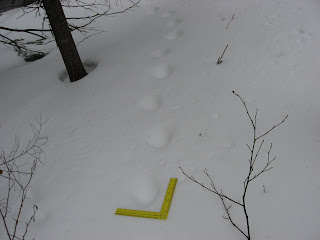Susan and I attended Walnut Hill's 1-day lynx tracking program on the
20th, and then spent a few hours the next morning tracking elsewhere on
our own. We were fortunate to find lynx tracks both days.
This was in central Maine, near Moosehead Lake, in early succession
spruce/fir forest, where there was a lot of snowshoe hare and grouse
activity. Both days, I was struck by how intensively the lynx used a
very small area with a lot of hare activity: Lynx trails criss crossed
through the hare hangouts. This makes sense, since this cat is a hare
specialist.
(Maybe I don't yet have enough experience to make this generalization,
but it seems to me that bobcats don't have as strong a tendency to
concentrate their efforts in such a small area. They seem to do more
opportunistic wandering, which would make sense, given the more varied
diet of the generalist bobcat.)
Although we saw no clean, crisp lynx tracks, it is easy to determine
lynx even from a poor, partially blown out or snowed over trail. The
first two photos show the typical direct registering walk in deep snow.
Note the huge tracks, wide straddle, and bobcat-like step length. No
other animal fits that picture. A cougar can make tracks that large,
but the stride will be much longer than that of a lynx trail.
The third photo shows tracks of the lynx's favorite prey, the snowshoe
hare. In deep snow, this animal can splay its toes to produce huge,
snowshoe-like tracks, as shown in this picture. When the snowshoe hare
does not splay its toes, the tracks look just like over-sized cottontail
tracks.
In the 4th photo, you see a pattern of tracks which looks like that of a
lagomorph, and, at first glance, we assumed it was snowshoe hare. But
those tracks were actually produced by a lynx, which bounded several
times in succession as it ascended a hill (and then resumed its
alternating walk). Like its prey, the predator is adapted to deep snow
with long, powerful hind legs, and huge feet, and will occasionally use
those long, strong legs to bound in the same manner as its prey.
The last photo shows a weenie weasel whisking off with dragging prey.





No comments:
Post a Comment